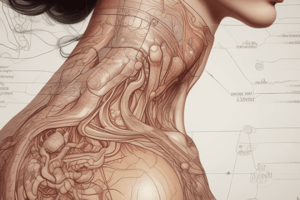Podcast
Questions and Answers
What is the outermost protective shield of the body?
What is the outermost protective shield of the body?
Epidermis
Which layer of the skin is tough and leathery, composed mostly of dense connective tissue?
Which layer of the skin is tough and leathery, composed mostly of dense connective tissue?
Dermis
What is the name of the layer that contains blood vessels and nerves within the dermis?
What is the name of the layer that contains blood vessels and nerves within the dermis?
Reticular layer
What type of tissue serves as energy storage and insulation under the skin?
What type of tissue serves as energy storage and insulation under the skin?
What is the function of sebaceous glands?
What is the function of sebaceous glands?
What are the sweat glands responsible for regulating body temperature called?
What are the sweat glands responsible for regulating body temperature called?
What is the area where hair roots are enclosed called?
What is the area where hair roots are enclosed called?
What connects hair follicles to the arrector pili muscle?
What connects hair follicles to the arrector pili muscle?
What part of the skin is often described as not being part of the skin?
What part of the skin is often described as not being part of the skin?
What are the small bumps on the skin that contain blood vessels and nerves called?
What are the small bumps on the skin that contain blood vessels and nerves called?
Flashcards are hidden until you start studying
Study Notes
Skin Structure Overview
- Skin comprises various layers and components providing protection, sensation, and thermoregulation.
Hair Shaft
- The visible part of the hair that extends above the skin surface.
Epidermis
- Outermost layer of skin composed mainly of epithelial cells.
- Acts as the primary protective barrier for the body.
Dermis
- Forms the bulk of skin structure beneath the epidermis.
- Composed of dense connective tissue, contributing to skin's toughness and elasticity.
Reticular Layer
- Deep layer of the dermis characterized by dense irregular connective tissue.
- Contains larger blood vessels, sweat glands, and hair follicles.
Papillary Layer
- Uppermost layer of the dermis, interdigitating with the epidermis.
- Contains small blood vessels and sensory receptors, enhancing nutrient supply and sensory function.
Adipose Tissue
- Fatty tissue located beneath the dermis (in the hypodermis).
- Serves as insulation and energy storage, also cushioning underlying structures.
Cutaneous Plexus
- Network of blood vessels located in the deeper dermis.
- Supplies nutrients to skin layers and aids in thermoregulation.
Hair Root
- Portion of the hair embedded within the hair follicle and situated below the skin surface.
Hair Follicle
- Structure housing the hair root; generates hair through the process of keratinization.
Sebaceous (oil) Gland
- Glands associated with hair follicles that secrete sebum to lubricate the skin and hair.
Eccrine Sweat Gland
- Major sweat glands found widely throughout the skin.
- Regulate temperature through perspiration and help in waste excretion.
Arrector Pili Muscle
- Small muscle connected to hair follicles.
- Causes hair to stand upright, contributing to "goosebumps" in response to cold or fear.
Sweat Pore
- Opening in the skin surface through which sweat is excreted.
- Plays a role in thermoregulation and waste removal.
Subpapillary Plexus
- Network of capillaries located just beneath the papillary layer of the dermis.
- Supplies nutrients and oxygen to the epidermis.
Dermal Papillae
- Finger-like projections of the dermis that extend into the epidermis.
- Enhance the surface area for exchange of oxygen, nutrients, and waste, also forming fingerprints.
Hair Follicle Receptor (Root Hair Plexus)
- Sensory nerve endings surrounding hair follicles.
- Detects hair movement, contributing to tactile sensation.
Lamellar Corpuscle
- Specialized sensory receptor located deeper in the skin.
- Responsible for detecting pressure and vibration.
Sensory Nerve Fiber with Free Nerve Endings
- Nerve fibers that terminate in the epidermis.
- Detects pain, temperature, and touch, playing a crucial role in sensory perception.
Hypodermis
- Also known as subcutaneous tissue, located beneath the dermis.
- Composed primarily of adipose tissue and not considered part of the skin itself; provides insulation and stores energy.
Studying That Suits You
Use AI to generate personalized quizzes and flashcards to suit your learning preferences.




